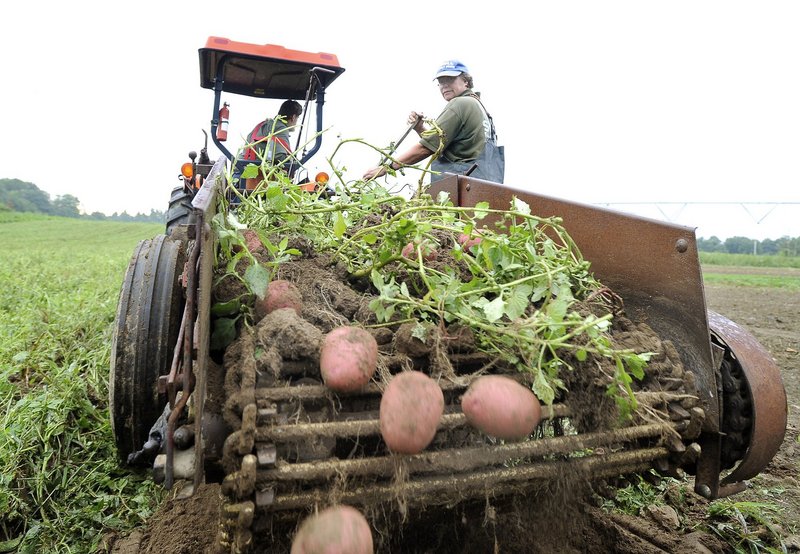Eating local gets a lot of lip service, but according to research done by Mark Lapping, only about 10 percent to 14 percent of the food eaten by the average Mainer comes from Maine.
“Right now Maine imports the vast, vast majority of its food and most of it comes in on trucks,” said Lapping, who is a distinguished professor at the University of Southern Maine’s Muskie School of Public Policy. “But many of us believe Maine has the capacity to produce more food.”
Lapping serves as one of the principal investigators for the Maine Food Strategy initiative, part of a broad-reaching effort to significantly boost these numbers while improving the livelihoods of farmers and fishermen.
This concerted attempt to grow the Maine food economy got under way last year and is now entering its second phase focused on outreach to stakeholders and other interested parties.
“We spent the first part of the project trying to get a sense of the range of other groups doing food system planning,” said project director Tanya Swain.
This included interviewing individuals and organizational representatives from around Maine and conducting an in-depth examination of more than 200 local food plans from cities, counties and states around the country.
“Now we need to get out there and start talking to people about priorities and find consensus about what is critical,” Swain said.
Coordinated by the University of Maine Cooperative Extension, the stakeholder meetings should kick off soon and run through early spring.
According to Amanda Beal, who serves on the board of the Eat Local Food Coalition and worked with Lapping to conduct the review of local food plans, the research revealed a number of core and emerging issues facing other communities trying to increase the amount of local food eaten by local people. Whether or not those working in the Maine food sector face the same issues remains to be seen.
Beal said some of the issues identified in other states and communities include streamlining existing regulations, protecting access to land and water, directing state and local governments to purchase a higher percentage of local foods, improving access to markets, increasing processing capacity and addressing challenges related to changing plant hardiness zones and warming ocean waters.
“Are these priority issues for Maine?” Beal asked. “We need to test these issues out with people doing the work on the ground.”
Swain said once the stakeholder meetings have taken place, the project leaders will collect what they’ve heard and create a strategy tailored to Maine.
“What we want to do is create a plan that has a fairly discrete number of manageable goals,” Swain said. “One to three years, three to five years and long-term goals. We could probably write a plan based on all the other work that’s happened, but we really need the buy-in and consensus of a lot of other players.”
One thing that will be an integral part of the Maine plan will be goals related to the state’s fishing and sea vegetable industries.
“We are excited that this project is really committed to looking at fisheries,” said Beal.
In 2009, the Eat Local Foods Coalition launched the By Land and By Sea project to draw attention to the fact that fisheries are a vital part of Maine’s local food system.
While the specific strategies have yet to be formulated, the overarching objectives of the plan are clear.
“One would certainly like to see more local food produced in Maine, processed in Maine and distributed in Maine,” Lapping said. “We’d like to see more Maine food dollars purchase Maine foods. We’d like to see the incomes of fishers and farmers grow. We’d like to see a more robust food processing sector.”
Achieving these objectives will require an understanding of existing challenges and opportunities.
Shelley Doak, another Maine Food Strategy participant and executive director of the Maine Grocers Association, said one way to help farmers and food processors get their products on store shelves is by continuing the mentoring programs offered by association members.
“What we’ve been trying to do is to provide education to food entrepreneurs and informing them of food safety standards, labeling requirements, production and distribution,” Doak said. “Helping them understand what the criteria is for getting their products from the production facility to the retailer, and that can often mean to the wholesaler who distributes to the retailers. It’s helping them follow the correct course.”
Doak said another promising initiative is the Market Ready Program launched last September by the Maine Food Producers Alliance.
The program aims to assist food processors in addressing regulatory and logistical issues, such as product safety testing and purchasing electricity on the industrial market.
People or organizations who want to be involved in the process are encouraged to visit mainefoodstrategy.org, where they can sign up for email updates, contact the project team with suggestions, volunteer to host a stakeholder meeting or join a working group.
“Our future food security ought to be one of the most important things to us,” Beal said. “We all need to eat. We know we want to eat well and be healthy and have good quality of life. This is the time we can be thinking forward to the opportunities that are ahead of us and ones we’re in the midst of.”
Staff Writer Avery Yale Kamila can be contacted at 791-6297 or at: akamila@pressherald.com
Twitter: AveryYaleKamila
Send questions/comments to the editors.




